Hikari Supra: Reunited with Its First Driver, This Racer Is Better Than Ever
Few Japanese cars in recent history have garnered the sort of fanfare and adolescent admiration that Toyota’s fourth-generation Supra Turbo has enjoyed. However, its potential on the road course is largely unknown or, more often than not, casually dismissed. Few Supras in the U.S. were modified into casual road-course weapons, and fewer examples of Toyota’s former flagship performance car ever saw sanctioned wheel-to-wheel competition on North American soil.
Housed in that elongated snout was an iron-block straight-six, the 2JZ-GTE, which spoiled the weight distribution slightly. Toyota did its homework, however, and despite its weight (a 1993 car weighs 3480 pounds) and curvaceous shape, the Supra was responsive and surefooted. Those willing and/or able to look past the renowned tuning potential of the powerplant might have recognized a car that could be more than a drag racer, but not many were interested in developing it in that way.
David Schardt, founder of wheel manufacturer Forgeline, was one exception. With the help of Toyota, he not only built a Mk IV Supra to compete in the World Challenge GT series, but, fifteen years after selling the car, he bought it back and made it better—and faster—than ever.
Japanese racers solved the problem of making the Supra corner like a real racer by ditching the big iron lump and using a silhouette body. From 1996 to 2004, GT500-spec Supras raced in the Japanese Grand Touring Championship using an aluminum, two-liter, twin-cam four-cylinder called the 3S-GTE. Its compact package helped move mass towards the middle of the Supra, and, thanks to the time that Toyota had spent refining the engine in the World Rally Championship, the little four-cylinder produced over 200 horsepower more than the 2JZ with which the Supra Turbo left the factory. Granted, a JGTC car shares little more than a silhouette with its production counterpart, but the Supras that competed in this series were, in many people’s eyes, the only fourth-gen models worthy of being called bonafide race cars.
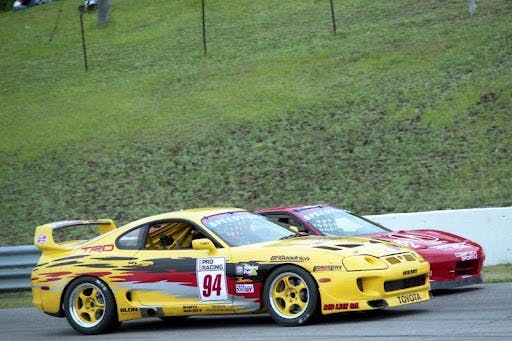
Stateside, there was no comparable series in which the Mk IV Supra showcased its strengths: stability, stopping power, a potent powerplant, and a shape that was not only pleasant to look at but relatively aerodynamic. However, IMSA’s Speedvision Cup series made room for a modified version of the production car to show its strengths in the Street Stock class. This class mandated all the cars stay semi-factory, which made the overbuilt and easily tuned Supra a candidate with real promise.
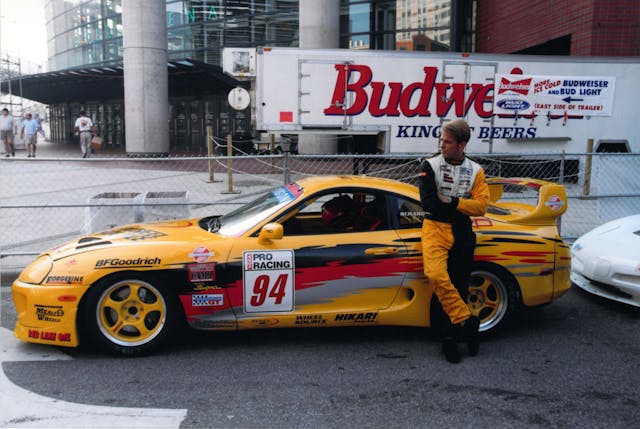
Among a field of proven Porsches, BMWs, and Mustang Cobras, David Schardt decided to campaign a fourth-generation Supra Turbo. With the help of Shawn Passen from Passen Motorsports, he procured two examples to run in the 1997 and 1998 seasons of the Speedvision Cup. Schardt and Passen mulled over a name that would suit their unproven Japanese sports GT and settled on hikari, Japanese for “light.”
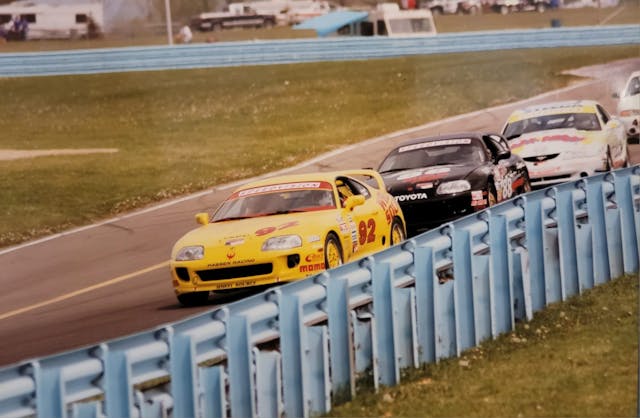
Once stripped of creature comforts, the Supra measured in at 3150 pounds. That made it a middleweight, though it was not so heavy as to overwhelm the factory four-piston calipers, which were quite good: In 1997, Road & Track found that the Supra Turbo could decelerate from 75 to a full stop in just 45 meters (147.6 feet). That stat remained unmatched among road-going vehicles for seven years, when the Porsche Carrera GT beat it.
The Hikari Supra didn’t need much to become road course–worthy, just Koni shocks, TRD swaybars, and a few bolt-on modifications to get the 2JZ breathing freely. (Funny how easily an uncorked 2JZ-GTE could produce 450 horsepower at a time when supercars made roughly the same power.) In this mildly modified state, the motor would run the race distance without losing power, overheating, or suffering any setbacks. “We ran multiple six-hour races with the car in that configuration without a hiccup,” Schardt recounts proudly. With co-driver Kelly Collins, Schardt enjoyed five top-ten finishes in the 1998 season. Fuel economy was what kept them from doing even better.
Cash injection
Toyota had noticed the Hikari Supra and wanted to give its flagship sports car a greater chance to shine. Factory backing can take an ambitious privateer team quite a long way and, with Toyota writing large checks to his team, Hikari Racing, Schardt decided to step into World Challenge GT for the 1999 season.
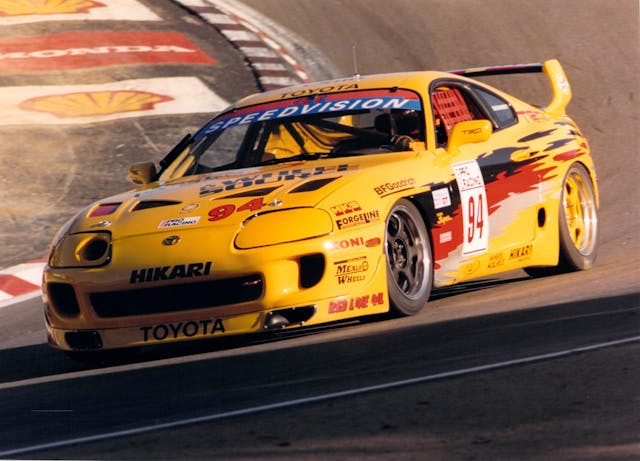
Since World Challenge’s rule set was more flexible, Toyota wanted the team to start with a clean slate. With a new VINless “crusher” chassis, Hikari Racing began exploring this car’s potential—particularly that of the engine. Out came the factory CT20 turbos and in went a massive Turbonetics TS03 unit.
The big turbo and supporting modifications doubled the factory power figures, but driveability went down the drain. With an aftermarket valvetrain oriented for optimal performance in the higher rev range, the promise for big power was there, but the limitations of aftermarket ECUs from twenty-five years meant power came on like a steam hammer. The MoTeC M48 ECU was cutting-edge stuff in 1999, but even it could not make the motor as tractable as road racing required.
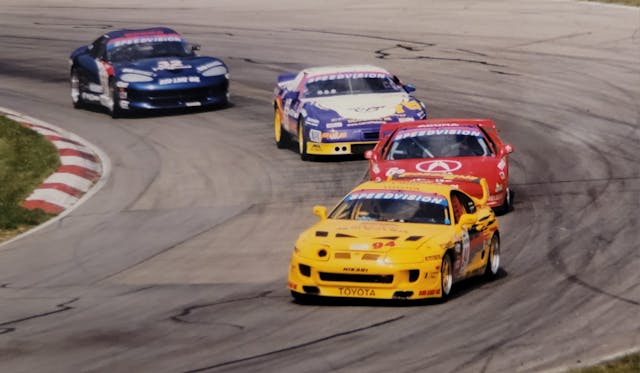
While the rules concerning the powerplant were relatively open, those concerning aerodynamic additions were stricter. An adjustable TRD wing and a custom splitter helped stabilize the Supra at speeds, but it wasn’t forced into the road as aggressively as a contemporary GT2 car, which had comparable power output. Like the other World Challenge cars the Supra was, essentially, a production car that relied primarily on mechanical grip and power to perform.
Schardt and his team ran a simple, effective setup similar to the one they had used for their Super Stock cars: Koni shocks, Eibach springs, and TRD swaybars. Where their setup differed was in the width of the footprint as per the rules of World Challenge GT. However, even 315-section BFGoodrich G-Force tires were too narrow to handle the mule-kick of 500 lb-ft of torque. In most races, the tires would be useless past half-distance; a large amount of their rubber had been painted on the asphalt in long, black streaks.
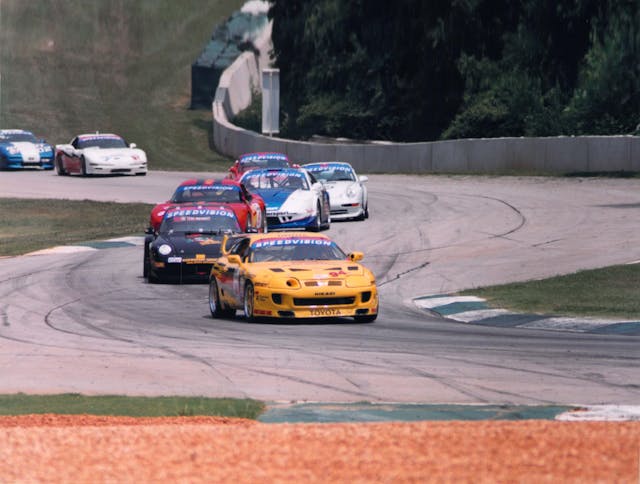
The added power did more than strain the driven tires. The engine struggled to stay cool for much longer than half of the race—even with the front-mounted HKS intercooler, which, unbeknownst to the team, was obstructing the necessary airflow through the central inlet to the Fluidyne radiator. Their World Challenge GT car was a sprint special: strong in qualifying and capable of sailing off into the distance within the first half of the race, but incapable of sustaining that performance. “It led many races, but never won one,” Schardt says wistfully.
Following the end of the ’99 season, Toyota pulled its funding for the Hikari Supra, which left Schardt with a bitter taste in his mouth. Still, their team had multiple top-five finishes and had finished fourth in the driver’s championship.
Toyota did supply Hikari Racing with two Celicas, but the company’s plan to promote that model didn’t go as successfully: Due to oiling issues, the Celicas never quite performed like their bigger brother. After a lackluster racing season, Schardt decided to park his Toyotas and focus on the growth of his wheel business, Forgeline. In 2001, he sold the Supra to an enthusiast in Ohio and moved on with his life, never expecting to see the rounded yellow hips of his World Challenge car again.
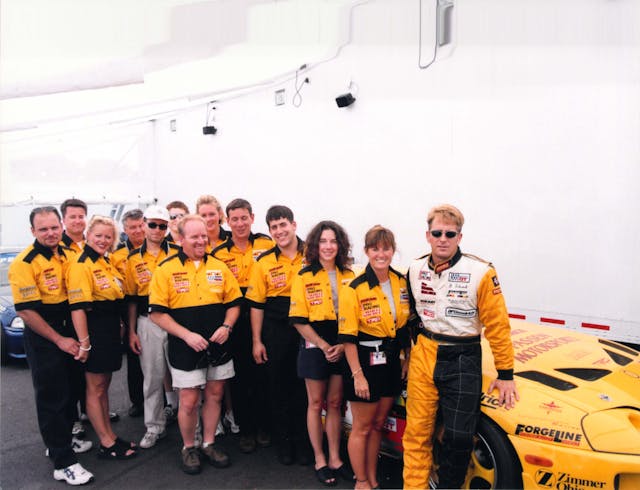
Fifteen years later, that familiar yellow shape popped up on eBay. Schardt, a calm and measured man, could not resist the pull of nostalgia. He made an offer—as it turned out, to the same man to whom he had sold the car in 2001. A couple weeks later, his old warhorse was unloaded at the foot of his driveway.
Schardt had to pinch himself. Though it had developed some patina, the car was cosmetically identical to the way it had left Schardt’s shop. “Even the original decals were still in place!” Schardt laughs.
Tidying up
Time had taken its toll on the Supra, so Schardt began rebuilding the car with the aftermarket support that simply hadn’t been available twenty years earlier. Spurred on by sentimentality, he wrote a few sizable checks that would do the old Supra justice.
First came the footwork. Hoosier R7 slicks now wrap Forgeline GW3R wheels at each corner. With Titan sway bars, MCS Double Adjustable shocks, and solid bushings all around, the Supra is even more surefooted and responsive than before, although the overall weight hasn’t changed. Two decades of improvements in tire tech make traction and turn-in far better than they were in the race car’s heyday.
So much of the old engine’s habit of overheating was due to poor management of aerodynamics. Titan’s custom undertray now helps direct airflow which once escaped underneath the car through the radiator. Also, the airflow through Supra’s inlets—two wing inlets and a larger central one—was not being wisely utilized back when the intercooler was positioned directly ahead of the radiator. After Schardt swapped the front-mount intercooler for a custom side-mount item housed in the area behind the right wing inlet, a known low-pressure zone, both coolers are fed more efficiently.

In pursuit of boost
Titan handled the engine rebuild, and this time used TMS 264 cams, Carillo rods, and CP pistons. The resulting 9:0:1 compression ratio is ideal for the high-boost setup, which comes courtesy of a Garrett GTW6465R turbocharger. To make the most of beefier internals and a big whistler, Schardt opted for a modern MoTeC M800 ECU. Not only does it help maximize power output across the entire rev range, but it supplies Schardt with a host of features to make the motor run more smoothly and safely. Few cars can match the Supra at places like Road America, save for some of the big-block cars.
Performance over the subsequent two seasons of vintage racing has been stellar—the Supra finished fourth in its class at Indianapolis in 2023—but racing takes its toll on even the strongest engines. A recent inspection of the oil pan showed plenty of glittery shavings. Schardt deferred to local Supra specialist Thomas Harless, who gave him the horrible prognosis: The crank bearings were damaged. A full rebuild was in order.
Schardt wasn’t fazed. Ever an optimist, he saw this as an opportunity to find more power and a touch more response—and he got half of what he wanted. After rebuilding the motor and adding a larger oil pump, he opted for a GTW3586 turbo for a more progressive onset of torque—or so he hoped. However, the new head, ported by Titan and boasting hotter cams, flows so well that the little GTW comes on violently. Schardt is back to the lightswitch power delivery of the old days.
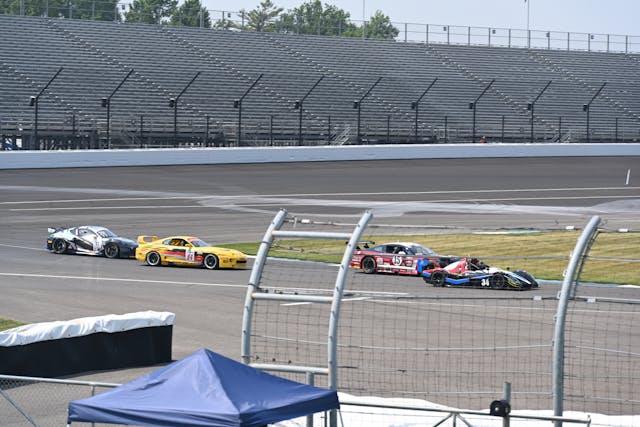
Although the latest iteration of the 2JZ isn’t as wieldy as he’d like, at least he doesn’t have to lift the hood most weekends. When he does, the motor is more easily serviceable than it’s ever been; additional MoTeC safeguards as well as a set of easily accessed wastegates have made mid-weekend fixes much easier.
Schardt’s World Challenge years might have been the best of his life, but reuniting with the car, optimizing it, and finally finishing on the SVRA podium is sweet, overdue vindication. Finally, the Supra has the reliability and stamina it lacked in its heyday. The big grand tourer has become more than a one-lap special: By finishing fourth in class at Indianapolis in 2023 against Mercedes, Porsche, and Audi GT3s from the 2000s and 2010s, the Supra has proven it’s fast, even by modern standards. “We’re gunning for a win next year,” Schardt said.
Plus, it regularly draws crowds. The old Supra is popular because it is quick, and because it spits fire and whistles away like no modern car will. If you ever see it race in person, you’ll understand why Schardt just couldn’t let his Supra stay away from him forever.
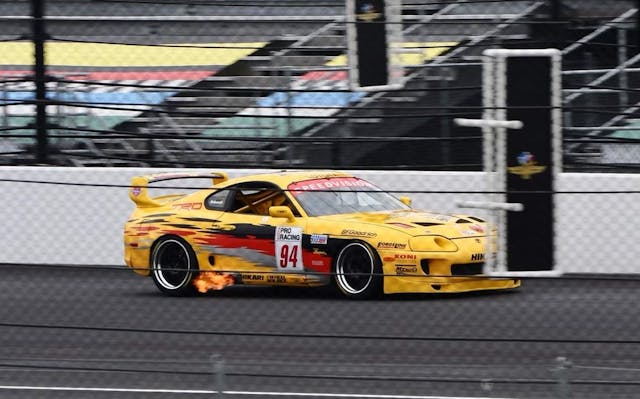
In 2024, Schardt plans to race the Supra the WeatherTech® International Challenge with Brian Redman at Road America (July 11–14) and at Historic Festival 42 at Lime Rock (August 30–September 2).
***
Check out the Hagerty Media homepage so you don’t miss a single story, or better yet, bookmark it. To get our best stories delivered right to your inbox, subscribe to our newsletters.



I’m looking forward to seeing this car race.
Andi Baritchi had success in Car And Driver’s One Lap Of America in the early 2000’s. I remember him placing 4th in one. These cars can do quite well on a road course but it is just more famous for drag racing for obvious reasons.